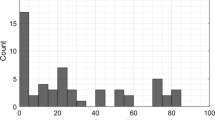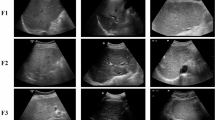Abstract
Purpose
Ultrasound (US) is the preferred modality for fatty liver disease diagnosis due to its noninvasive, real-time, and cost-effective imaging capabilities. However, traditional B-mode US is qualitative, and therefore, the assessment is very subjective. Computer-aided diagnostic tools can improve the specificity and sensitivity of US and help clinicians to perform uniform diagnoses.
Methods
In this work, we propose a novel deep learning model for nonalcoholic fatty liver disease classification from US data. We design a multi-feature guided multi-scale residual convolutional neural network (CNN) architecture to capture features of different receptive fields. B-mode US images are combined with their corresponding local phase filtered images and radial symmetry transformed images as multi-feature inputs for the network. Various fusion strategies are studied to improve prediction accuracy. We evaluate the designed network architectures on B-mode in vivo liver US images collected from 55 subjects. We also provide quantitative results by comparing our proposed multi-feature CNN architecture against traditional CNN designs and machine learning methods.
Results
Quantitative results show an average classification accuracy above 90% over tenfold cross-validation. Our proposed method achieves a 97.8% area under the ROC curve (AUC) for the patient-specific leave-one-out cross-validation (LOOCV) evaluation. Comprehensive validation results further demonstrate that our proposed approaches achieve significant improvements compared to training mono-feature CNN architectures (\(p<0.05\)).
Conclusions
Feature combination is valuable for the traditional classification methods, and the use of multi-scale CNN can improve liver classification accuracy. Based on the promising performance, the proposed method has the potential in practical applications to help radiologists diagnose nonalcoholic fatty liver disease.





Similar content being viewed by others
References
Targher G, Day CP, Bonora E (2010) Risk of cardiovascular disease in patients with nonalcoholic fatty liver disease. New England J Med 363(14):1341–1350
Nasr P, Ignatova S, Kechagias S, Ekstedt M (2018) Natural history of nonalcoholic fatty liver disease: a prospective follow-up study with serial biopsies. Hepatol Commun 2(2):199–210
Tapper EB, Lok ASF (2017) Use of liver imaging and biopsy in clinical practice. New England J Med 377(8):756–768
Li Q, Dhyani M, Grajo JR, Sirlin C, Samir AE (2018) Current status of imaging in nonalcoholic fatty liver disease. World J Hepatol 10(8):530
Khov N, Sharma A, Riley TR (2014) Bedside ultrasound in the diagnosis of nonalcoholic fatty liver disease. World J Gastroenterol 20(22):6821
Acharya UR, Raghavendra U, Fujita H, Hagiwara Y, Koh JE, Hong TJ, Sudarshan VK, Vijayananthan A, Yeong CH, Gudigar A et al (2016) Automated characterization of fatty liver disease and cirrhosis using curvelet transform and entropy features extracted from ultrasound images. Comput Biol Med 79:250–258
Strauss S, Gavish E, Gottlieb P, Katsnelson L (2007) Interobserver and intraobserver variability in the sonographic assessment of fatty liver. Am J Roentgenol 189(6):W320–W323
Andrade A, Silva JS, Santos J, Belo-Soares P (2012) Classifier approaches for liver steatosis using ultrasound images. Procedia Technol 5:763–770
Meng D, Zhang L, Cao G, Cao W, Zhang G, Hu B (2017) Liver fibrosis classification based on transfer learning and fcnet for ultrasound images. IEEE Access 5:5804–5810
Liu X, Song J, Wang S, Zhao J, Chen Y (2017) Learning to diagnose cirrhosis with liver capsule guided ultrasound image classification. Sensors 17(1):149
Reddy DS, Bharath R, Rajalakshmi P (2018) Classification of nonalcoholic fatty liver texture using convolution neural networks. In: 2018 IEEE 20th international conference on e-health networking, applications and services (Healthcom). IEEE, pp 1–5
Biswas M, Kuppili V, Edla DR, Suri HS, Saba L, Marinhoe RT, Sanches JM, Suri JS (2018) Symtosis: a liver ultrasound tissue characterization and risk stratification in optimized deep learning paradigm. Comput Methods Prog Biomed 155:165–177
Byra M, Styczynski G, Szmigielski C, Kalinowski P, Michałowski Ł, Paluszkiewicz R, Ziarkiewicz-Wróblewska B, Zieniewicz K, Sobieraj P, Nowicki A (2018) Transfer learning with deep convolutional neural network for liver steatosis assessment in ultrasound images. Int J Comput Assist Radiol Surg 13(12):1895–1903
Saba L, Dey N, Ashour AS, Samanta S, Nath SS, Chakraborty S, Sanches J, Kumar D, Marinho R, Suri JS (2016) Automated stratification of liver disease in ultrasound: an online accurate feature classification paradigm. Comput Methods Prog Biomed 130:118–134
Kuppili V, Biswas M, Sreekumar A, Suri HS, Saba L, Edla DR, Marinhoe RT, Sanches JM, Suri JS (2017) Extreme learning machine framework for risk stratification of fatty liver disease using ultrasound tissue characterization. J Med Syst 41(10):1–20
Qi X, Brown LG, Foran DJ, Nosher J, Hacihaliloglu I (2020) Chest x-ray image phase features for improved diagnosis of covid-19 using convolutional neural network. Int J Comput Assist Radiol Surg 1–10
Mwikirize C, Nosher JL, Hacihaliloglu I (2019) Single shot needle tip localization in 2d ultrasound. In: International conference on medical image computing and computer-assisted intervention. Springer, pp 637–645
Alsinan AZ, Patel VM, Hacihaliloglu I (2019) Automatic segmentation of bone surfaces from ultrasound using a filter-layer-guided cnn. Int J Comput Assist Radiol Surg 14(5):775–783
Hacihaliloglu I (2017) Enhancement of bone shadow region using local phase-based ultrasound transmission maps. Int J Comput Assist Radiol Surg 12(6):951–960
Mwikirize C, Nosher JL, Hacihaliloglu I (2018) Signal attenuation maps for needle enhancement and localization in 2d ultrasound. Int J Comput Assist Radiol Surg 13(3):363–374
Felsberg M, Sommer G (2001) The monogenic signal. IEEE Trans Sig Process 49(12):3136–3144
Belaid A, Boukerroui D (2014) A new generalised \(\alpha \) scale spaces quadrature filters. Pattern Recogn 47(10):3209–3224
Loy G, Zelinsky A (2003) Fast radial symmetry for detecting points of interest. IEEE Trans Patt Anal Mach Intell 8:959–973
Liu R, Wang F, Yang B, Qin SJ (2019) Multi-scale kernel based residual convolutional neural network for motor fault diagnosis under non-stationary conditions. IEEE Trans Indus Inform
Nowak E, Jurie F, Triggs B (2006) Sampling strategies for bag-of-features image classification. In: European conference on computer vision. Springer, pp 490–503
He K, Zhang X, Ren S, Sun J (2016) Deep residual learning for image recognition. In: Proceedings of the IEEE conference on computer vision and pattern recognition, pp 770–778
Funding
None.
Author information
Authors and Affiliations
Corresponding author
Ethics declarations
Conflict of interest
The authors declare that they have no conflict of interest.
Ethical approval
The article uses open source dataset.
Additional information
Publisher's Note
Springer Nature remains neutral with regard to jurisdictional claims in published maps and institutional affiliations.
Supplementary Information
Below is the link to the electronic supplementary material.
Rights and permissions
About this article
Cite this article
Che, H., Brown, L.G., Foran, D.J. et al. Liver disease classification from ultrasound using multi-scale CNN. Int J CARS 16, 1537–1548 (2021). https://doi.org/10.1007/s11548-021-02414-0
Received:
Accepted:
Published:
Issue Date:
DOI: https://doi.org/10.1007/s11548-021-02414-0




